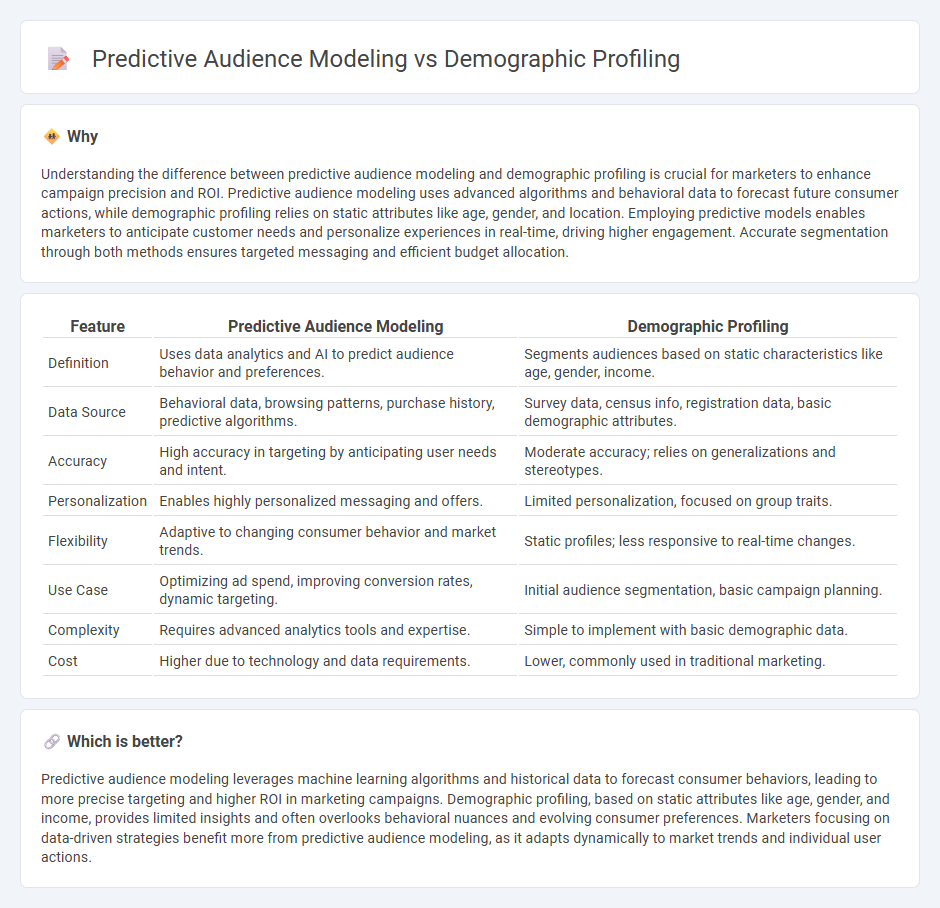
Predictive audience modeling uses data analytics and machine learning to anticipate consumer behaviors and preferences, enabling highly targeted marketing campaigns. Demographic profiling categorizes audiences based on attributes like age, gender, and income but often lacks the depth to predict future actions accurately. Explore how integrating predictive audience modeling can revolutionize your marketing strategy beyond traditional demographic profiling.
Why it is important
Understanding the difference between predictive audience modeling and demographic profiling is crucial for marketers to enhance campaign precision and ROI. Predictive audience modeling uses advanced algorithms and behavioral data to forecast future consumer actions, while demographic profiling relies on static attributes like age, gender, and location. Employing predictive models enables marketers to anticipate customer needs and personalize experiences in real-time, driving higher engagement. Accurate segmentation through both methods ensures targeted messaging and efficient budget allocation.
Comparison Table
| Feature | Predictive Audience Modeling | Demographic Profiling |
|---|---|---|
| Definition | Uses data analytics and AI to predict audience behavior and preferences. | Segments audiences based on static characteristics like age, gender, income. |
| Data Source | Behavioral data, browsing patterns, purchase history, predictive algorithms. | Survey data, census info, registration data, basic demographic attributes. |
| Accuracy | High accuracy in targeting by anticipating user needs and intent. | Moderate accuracy; relies on generalizations and stereotypes. |
| Personalization | Enables highly personalized messaging and offers. | Limited personalization, focused on group traits. |
| Flexibility | Adaptive to changing consumer behavior and market trends. | Static profiles; less responsive to real-time changes. |
| Use Case | Optimizing ad spend, improving conversion rates, dynamic targeting. | Initial audience segmentation, basic campaign planning. |
| Complexity | Requires advanced analytics tools and expertise. | Simple to implement with basic demographic data. |
| Cost | Higher due to technology and data requirements. | Lower, commonly used in traditional marketing. |
Which is better?
Predictive audience modeling leverages machine learning algorithms and historical data to forecast consumer behaviors, leading to more precise targeting and higher ROI in marketing campaigns. Demographic profiling, based on static attributes like age, gender, and income, provides limited insights and often overlooks behavioral nuances and evolving consumer preferences. Marketers focusing on data-driven strategies benefit more from predictive audience modeling, as it adapts dynamically to market trends and individual user actions.
Connection
Predictive audience modeling leverages demographic profiling data to forecast consumer behavior and preferences with high accuracy. Demographic profiling provides detailed insights into age, gender, income, and location, which serve as critical variables in building predictive models. This connection enables marketers to create targeted campaigns that optimize engagement and conversion rates by anticipating audience needs.
Key Terms
**Demographic Profiling:**
Demographic profiling segments audiences based on age, gender, income, education, and location, enabling targeted marketing strategies that resonate with specific population groups. This method leverages statistical data and census information to create clear customer personas, optimizing campaign relevance and resource allocation. Explore how demographic profiling can enhance your marketing precision and customer engagement.
Age
Demographic profiling segments audiences based on age groups to categorize consumer behaviors and preferences, relying on historical data for precise targeting. Predictive audience modeling uses machine learning algorithms to analyze age-related patterns, forecasting future behaviors and optimizing marketing strategies. Explore how integrating these methods can enhance audience engagement through age-specific insights.
Gender
Demographic profiling segments audiences based on gender to understand behavior patterns and preferences, providing clear categories for marketing strategies. Predictive audience modeling uses machine learning algorithms to analyze gender-related data alongside other variables, forecasting future behaviors and optimizing targeting accuracy. Discover how leveraging gender-focused models can enhance campaign effectiveness and drive better engagement.
Source and External Links
How to use demographic profiling to discover your audience - Userism - Demographic profiling involves gathering general traits like age, location, and purchasing habits to understand target customers better and includes steps such as defining objectives, data gathering, and segmenting data for insights.
13 Demographic Survey Questions (with Examples + Tips) - SurveyMonkey - Demographic profiling uses questions about age, gender, income, education, living situation, and language to categorize people and tailor marketing strategies.
Lesson 3: Creating a Demographic Profile - MEASURE Evaluation - A demographic profile examines population characteristics like age, sex distribution, household size, and employment status to assist in planning services and understanding population changes over time.
 dowidth.com
dowidth.com